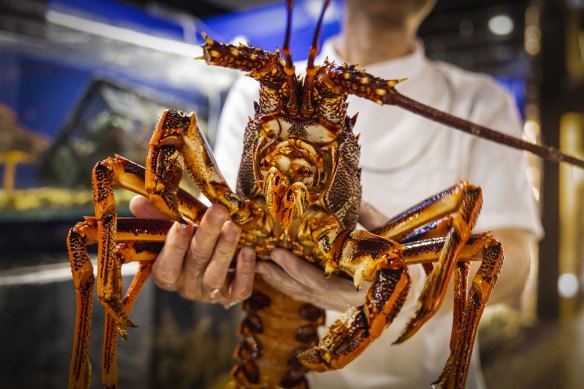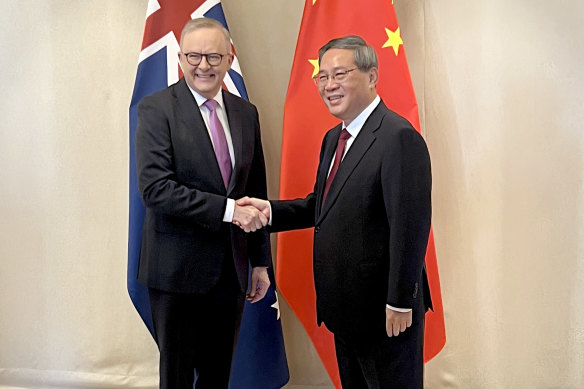- Updated
- World
- Asia
- China relations
This was published 9 months ago
China’s $20b Australian trade war over as lobster trade resumes
By Lisa Visentin and Mike Foley
The final block in a $20 billion trade embargo on Australian exports to China has been lifted, with Prime Minister Anthony Albanese announcing he had struck an agreement with Chinese Premier Li Qiang to reopen exports of live lobsters.
Albanese finalised the agreement on Thursday morning in a one-on-one meeting with Premier Li on the sidelines of the ASEAN summit in Laos.

The sanction on rock lobsters will be lifted in time for Chinese New Year. Credit: Jessica Hromas
“Premier Li and I agreed on a timetable to resume full lobster trade by the end of this year. This, of course, will be in time for Chinese New Year,” Albanese said.
China’s imposed $20 billion of trade sanctions as an act of political retribution against the Morrison government in 2020, hitting barley, wine, lobster, timber, major beef exporters, timber and cotton.
The bans came in response to then-prime minister Scott Morrison’s push for an independent coronavirus inquiry, with China citing labelling and health certificate requirements as reasons for the beef bans, and claimed biosecurity issues were the reason for the lobster, cotton, barley and timber restrictions.
Australia’s lobster exports were the last agricultural commodity to remain barred from the massive Chinese market, with the exception of two beef exporters that remain suspended for technical reasons.

PM Anthony Albanese and Chinese Premier Li Qiang on the sidelines of the ASEAN summit.Credit: Tom McIlroy/AFR
The economic sanctions rocked the Australia-China trade relationship, delivering profound financial blows to industries and businesses that were heavily reliant on the Chinese market, leaving them scrambling to diversify and find alternative countries to export to.
More than 90 per cent of the Australian rock lobster trade was exported to China before the trade restrictions, worth about $770 million. The ban resulted in a spike in Australian exports to nearby markets, including Hong Kong, Taiwan and Vietnam, amid reports of lobsters being smuggled across the border in a flourishing of black market trade.
The gradual lifting of the Chinese sanctions began in January 2023, with the removal of the ban on Australian coal, followed by timber in May of that year, and barley in August. The wine ban was lifted in March this year, and the ban on most beef exporters removed in May.
Coal is one of Australia’s top three exports, along with iron ore and gas, and the shock ban caught exporters by surprise, leaving dozens of vessels stranded off China’s coastline unable to dock. Australia is a major coal producer and China’s ban forced a realignment of global trade flows, leading to Australian producers moving into new markets, including South-East Asia and India. China replaced Australian coal in part with Russian exports, but since the ban lifted at the start of 2023, Australian exports have soared and it is now the largest Chinese supplier.
Australian wine growers lost their biggest, most lucrative market overnight when China slapped tariffs of more than 200 per cent on their products, effectively cutting off access to its $1.2 billion market, leaving many suppliers in the industry with an oversupply of red wine.
Wine producers report encouraging sales since the export ban was lifted in March, but in the meantime France captured around 50 per cent of China’s market share, and Chile 20 per cent, so the future remains uncertain for Australian growers.
Albanese said the government’s “patient, calibrated and deliberate approach” had led to the restoration of trade ties with Australia’s largest export market, praising the work done to effect “the removal of trade impediments one by one”.
“The premier pointed out the quite considerable growth that has occurred in Australian exports, including wine and barley, that has grown to be larger than what was there before there were impediments to that trade.”
Trade Minister Don Farrell and Foreign Minister Penny Wong urged Australian businesses to continue to diversify their trade markets beyond China.
China’s veto on Australia’s lobsters came swiftly. Live shellfish worth $2 million were stranded on the tarmac at Chinese airports on November 1, 2020 when a sudden ban was imposed via increased customs inspections that brought imports to a halt.
Lobster exporter Andrew Ferguson, who runs Ferguson Australia in South Australia, said he welcomed the end to four years of confusion.
However, Ferguson said it remained unclear how the China export market would recover.
“Whether the market is the same as where it left off, that’s the big question. I seriously don’t think it will be the same volume or the pricing,” he said.
“It gives us another big option, but we’ve done a lot of work in other markets and we’ve developed products in the supermarkets and a lot of the supermarkets in Australia have now got our products.
“But we’ll learn from the experience that we can’t keep all our eggs in one basket.”
A spokesman for peak industry representative the Australian Meat Industry Council said discussions with China about lifting restrictions on the two abattoirs that remain barred are “well-progressed” and it is hopeful of a swift resolution.
Cut through the noise of federal politics with news, views and expert analysis. Subscribers can sign up to our weekly Inside Politics newsletter.